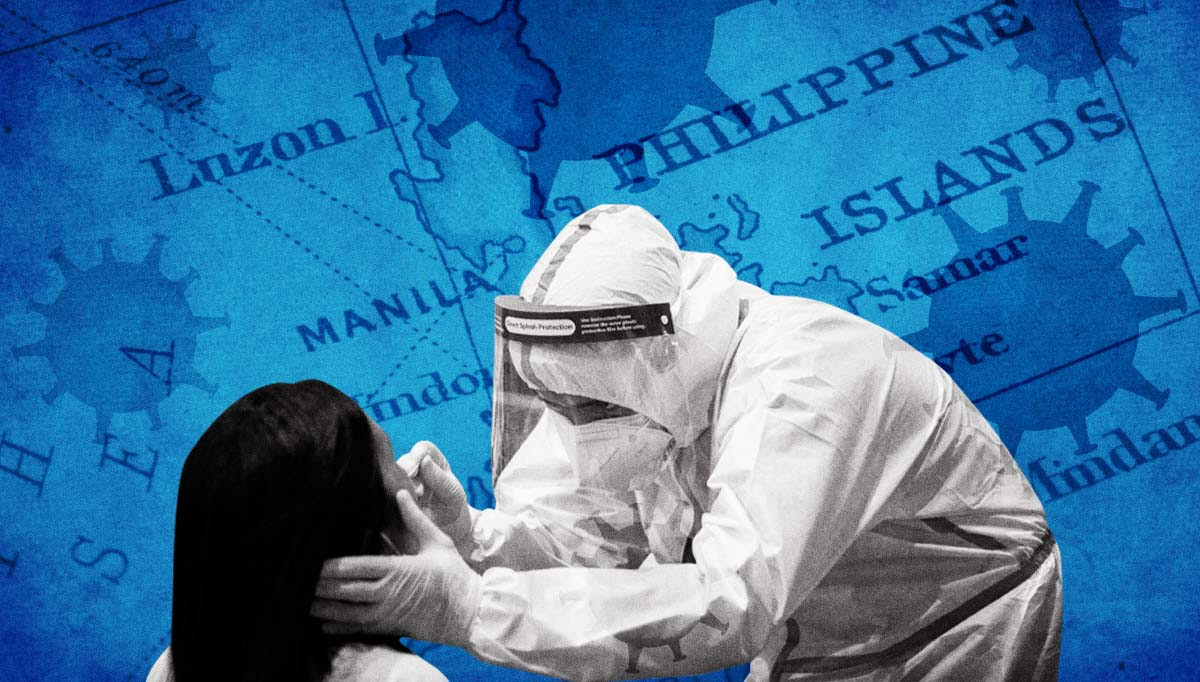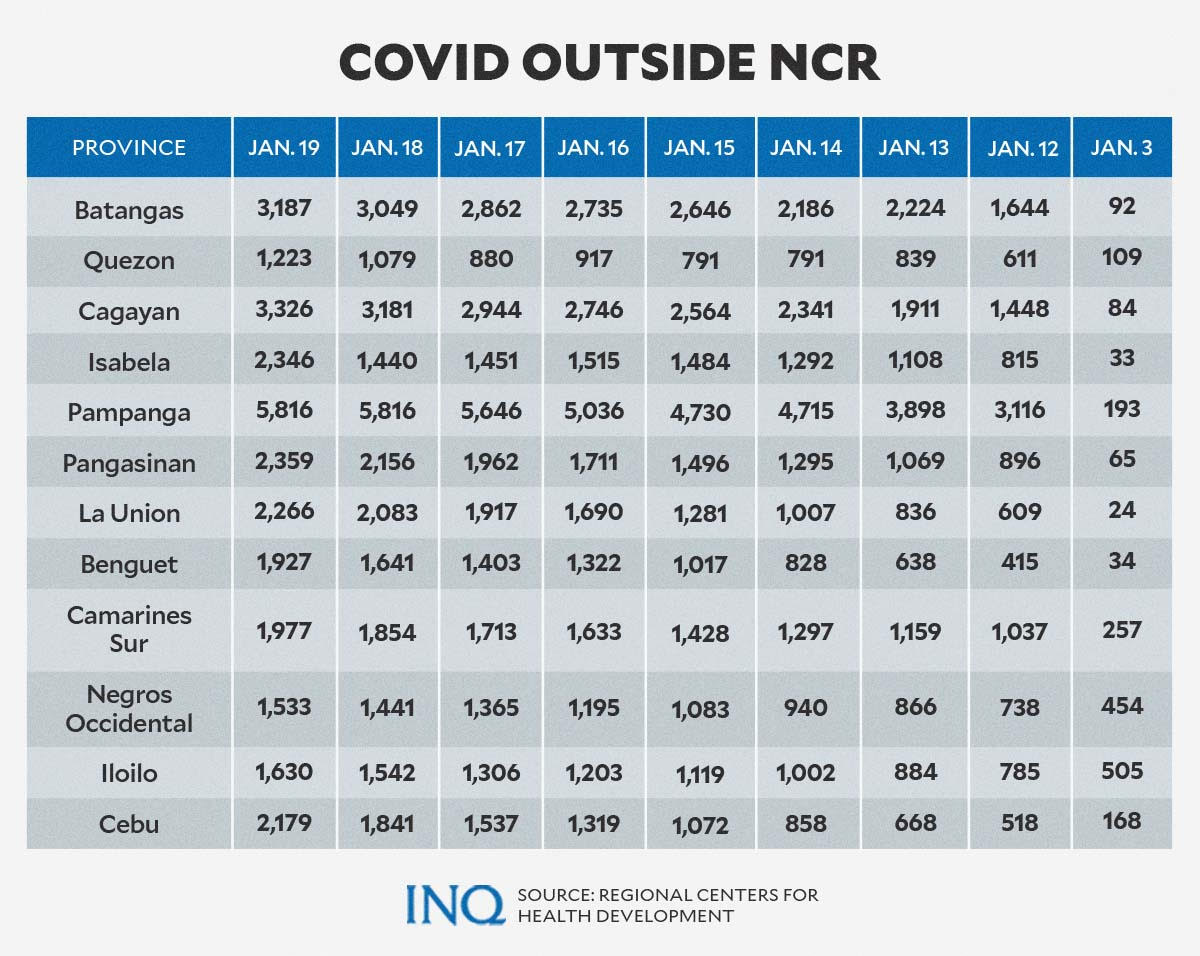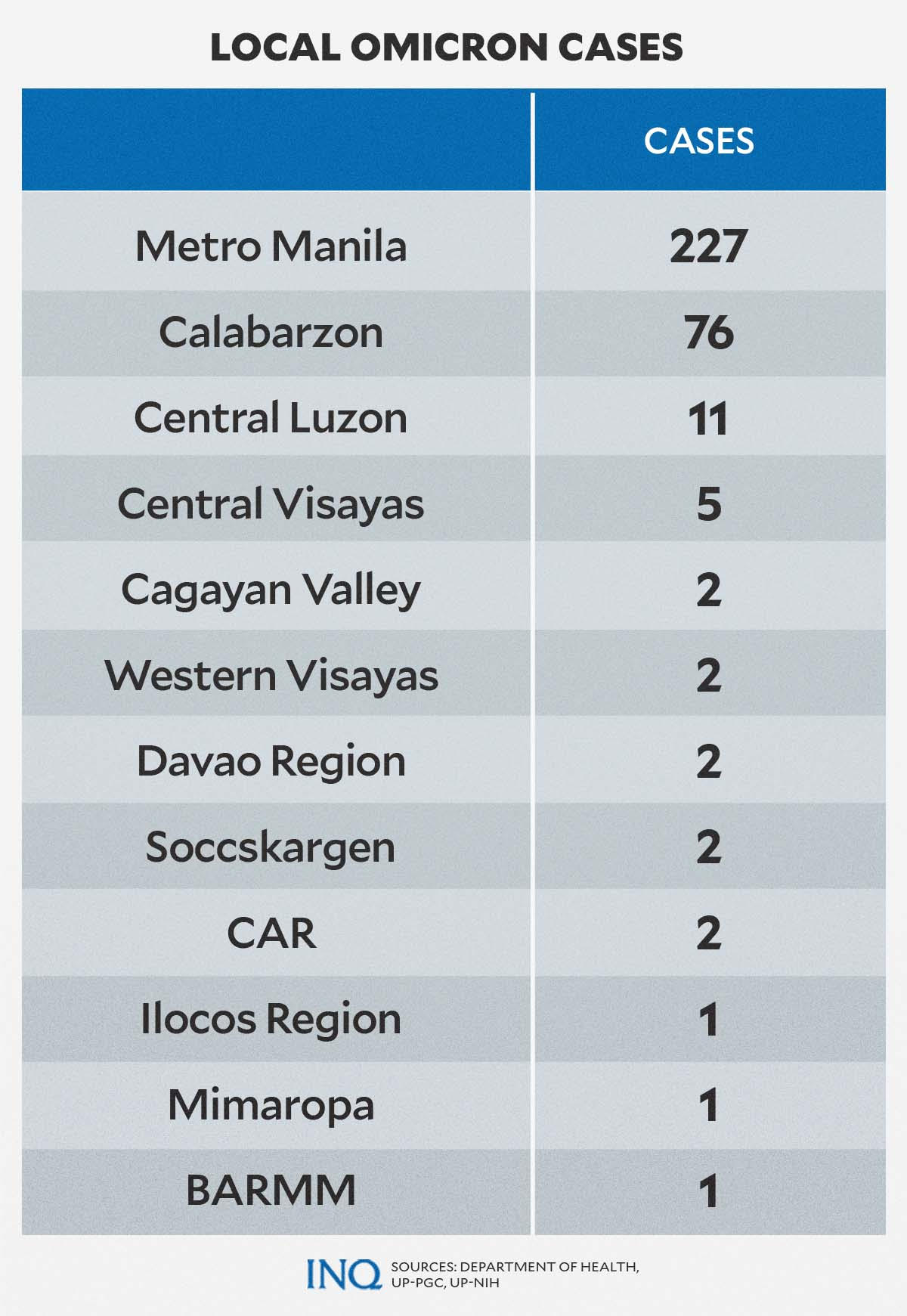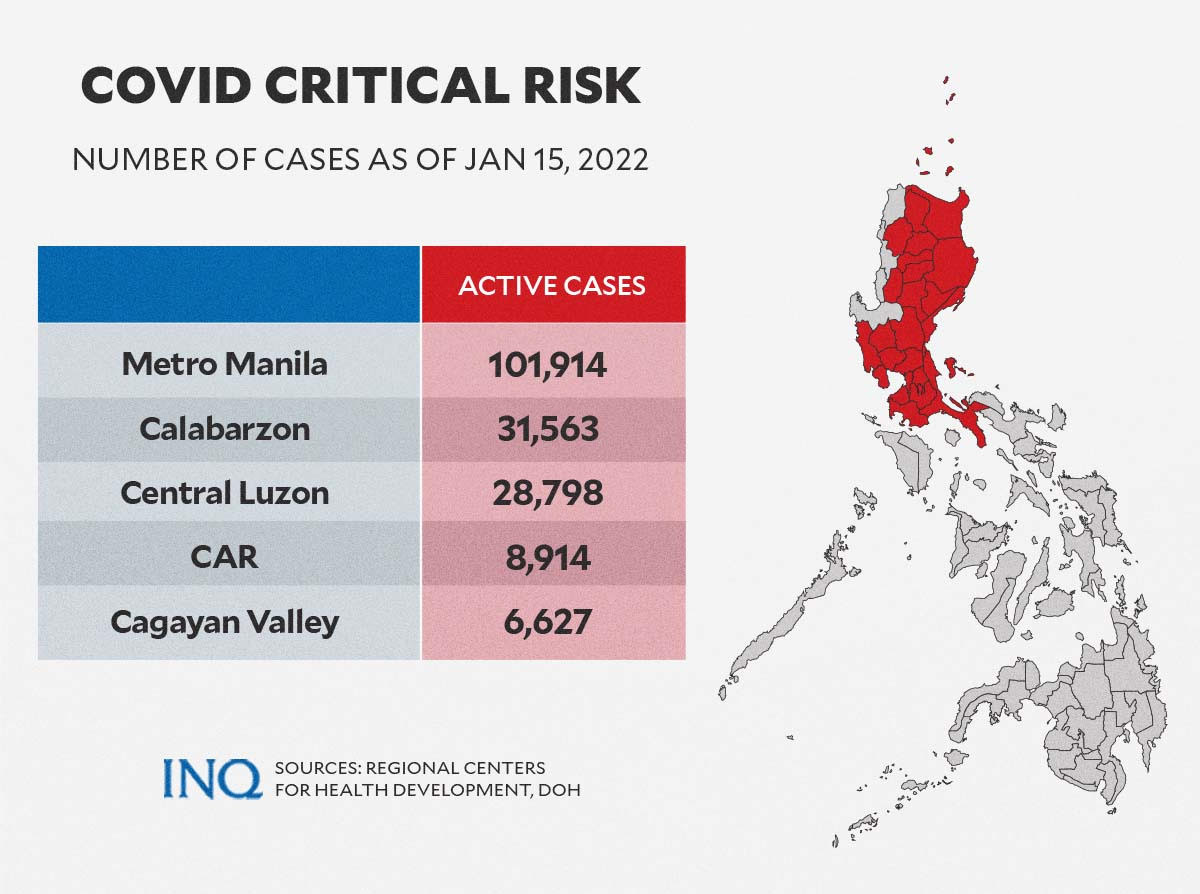COVID surge moves outside NCR, raises cases by 200 percent in provinces

Artwork by Ed Lustan
MANILA, Philippines—While a “steady decrease” in COVID-19 cases was seen in Metro Manila, new cases outside the region and the provinces of Cavite, Laguna, Rizal, and Bulacan are rising exponentially.
READ: Cautious optimism swirls around NCR as COVID cases decline
This was declared by Dr. Guido David, a fellow of OCTA Research, who said that from less than 4,000 on Jan. 12, new COVID-19 cases outside NCR Plus spiked to almost 12,000 on Jan. 20–a 200 percent increase in just eight days.
This surge was also seen by the Department of Health (DOH) on Jan. 18 with health officials saying that while there were provinces with lower COVID-19 cases than NCR Plus, “continuous and swift increases” in infections were observed in all provinces.
READ: COVID-19 cases surging in all regions and provinces, says DOH
David said on Twitter that the areas with the most new COVID-19 cases on Jan. 20 were Metro Manila, Laguna, Cavite, Cebu, Rizal, Bulacan, Batangas, Davao del Sur, Iloilo, Pampanga, Benguet, and Misamis Oriental.

Graphic: Ed Lustan
The other provinces with notable spikes in cases were Isabela, Pangasinan, Negros Occidental, Bataan, Zamboanga del Sur, Cagayan, Leyte, and Camarines Sur. Currently, the Philippines has 275,364 active COVID-19 cases.
INQUIRER.net consolidated data from the DOH and Centers for Health Development to have a grasp of how COVID-19 cases spiked in some of the provinces which only had an average of 20 to 500 active cases on Jan. 3:
-
Batangas
Jan. 19: 3,187
Jan. 18: 3,049
Jan. 17: 2,862
Jan. 16: 2,735
Jan. 15: 2,646
Jan. 14: 2,186
Jan. 13: 2,224
Jan. 12: 1,644
Jan. 3: 92
-
Quezon
Jan. 19: 1,223
Jan. 18: 1,079
Jan. 17: 880
Jan. 16: 917
Jan. 15: 791
Jan. 14: 791
Jan. 13: 839
Jan. 12: 611
Jan. 3: 109
-
Cagayan
Jan. 19: 3,326
Jan. 18: 3,181
Jan. 17: 2,944
Jan. 16: 2,746
Jan. 15: 2,564
Jan. 14: 2,341
Jan. 13: 1,911
Jan. 12: 1,448
Jan. 3: 84
-
Isabela
Jan. 19: 2,346
Jan. 18: 1,440
Jan. 17: 1,451
Jan. 16: 1,515
Jan. 15: 1,484
Jan. 14: 1,292
Jan. 13: 1,108
Jan. 12: 815
Jan. 3: 33
-
Pampanga
Jan. 19: 5,816
Jan. 18: 5,816
Jan. 17: 5,646
Jan. 16: 5,036
Jan. 15: 4,730
Jan. 14: 4,715
Jan. 13: 3,898
Jan. 12: 3,116
Jan. 3: 193
-
Pangasinan
Jan. 19: 2,359
Jan. 18: 2,156
Jan. 17: 1,962
Jan. 16: 1,711
Jan. 15: 1,496
Jan. 14: 1,295
Jan. 13: 1,069
Jan. 12: 896
Jan. 3: 65
-
La Union
Jan. 19: 2,266
Jan. 18: 2,083
Jan. 17: 1,917
Jan. 16: 1,690
Jan. 15: 1,281
Jan. 14: 1,007
Jan. 13: 836
Jan. 12: 609
Jan. 3: 24
-
Benguet
Jan. 19: 1,927
Jan. 18: 1,641
Jan. 17: 1,403
Jan. 16: 1,322
Jan. 15: 1,017
Jan. 14: 828
Jan. 13: 638
Jan. 12: 415
Jan. 3: 34
-
Camarines Sur
Jan. 19: 1,977
Jan. 18: 1,854
Jan. 17: 1,713
Jan. 16: 1,633
Jan. 15: 1,428
Jan. 14: 1,297
Jan. 13: 1,159
Jan. 12: 1,037
Jan. 3: 257
-
Negros Occidental
Jan. 19: 1,533
Jan. 18: 1,441
Jan. 17: 1,365
Jan. 16: 1,195
Jan. 15: 1,083
Jan. 14: 940
Jan. 13: 866
Jan. 12: 738
Jan. 3: 454
-
Iloilo
Jan. 19: 1,630
Jan. 18: 1,542
Jan. 17: 1,306
Jan. 16: 1,203
Jan. 15: 1,119
Jan. 14: 1,002
Jan. 13: 884
Jan. 12: 785
Jan. 3: 505
-
Cebu
Jan. 19: 2,179
Jan. 18: 1,841
Jan. 17: 1,537
Jan. 16: 1,319
Jan. 15: 1,072
Jan. 14: 858
Jan. 13: 668
Jan. 12: 518
Jan. 3: 168
Omicron in PH
Dr. Alethea de Guzman, director of the Epidemiology Bureau of the DOH, said the rise in COVID-19 cases was driven by the Omicron, a more contagious variant of SARS CoV2, the virus that causes the disease.
She explained, however, that this was likewise driven by increased mobility, reduced compliance with minimum public health standards, as well as delays in detection and isolation.

Graphic by Ed Lustan
Last. Jan. 19, the DOH and the Philippine Genome Center and National Institutes for Health of the University of the Philippines said there were 535 cases of Omicron in the Philippines.
They said 495 of the 535 Omicron cases were detected from specimens that were sequenced on Jan. 14. These consist of 332 local cases and 160 returning overseas Filipinos.
The DOH, last Jan. 15, confirmed the community transmission of Omicron in Metro Manila, saying that while genome sequencing efforts could not keep up with the spike in COVID-19 cases, “we already have determined that there are local cases already.”
READ: DOH confirms community transmission of Omicron variant in Metro Manila

Graphic by Ed Lustan
There are 227 Omicron cases in Metro Manila; 76 in Calabarzon, 11 in Central Luzon, five in Central Visayas; two cases each in Cagayan Valley, Western Visayas, Davao Region, Soccsksargen, and Cordillera Administrative Region (CAR).
Ilocos Region, Mimaropa, and the Bangsamoro Autonomous Region in Muslim Mindanao have one Omicron case each. The government said 467 have already been tagged as recovered.
Health Undersecretary Maria Rosario Vergeire, also spokesperson of the DOH, had said that if this kind of transmission persists, the time will come that Omicron will become the dominant COVID virus variant in the Philippines.
Critical risk
Last. Jan. 15, the DOH identified five regions–Metro Manila, Calabarzon, Cagayan, Valley, CAR, and Central Luzon–with critical case risk classification for COVID-19. The rest of the regions have high-risk classification.
Based on data from the DOH and the Centers for Health Development, Metro Manila has 101,914 active cases; Calabarzon has 31,563; Cagayan Valley has 6,627; CAR has 8,914; and Central Luzon has 28,798.
These regions were also consistently on the list of regions with most new COVID-19 cases. The others were Bicol Region, Central Visayas, Western Visayas, Eastern Visayas, Davao Region, Northern Mindanao, and Zamboanga Peninsula.
Malacañang, last Jan. 20, said that the stricter Alert Level 4 will be imposed in Kalinga, Ifugao, Mountain Province, and Northern Samar from Jan. 21 to 31. Alert Level 3 had been previously imposed in these provinces.
While COVID-19 cases in the Philippines already reached 3.3 million with 31,173 new cases that were confirmed on Jan. 20, the DOH previously said “we are still yet to see the peak which may happen by the end of this month or even later in the second week of February.”
David, who expects “roughly the same range of new cases [of] about 29,000 to 33,000 total with a median of 31,000,” said people should continue to comply with health protocols.
TSB
For more news about the novel coronavirus click here.
What you need to know about Coronavirus.
For more information on COVID-19, call the DOH Hotline: (02) 86517800 local 1149/1150.
The Inquirer Foundation supports our healthcare frontliners and is still accepting cash donations to be deposited at Banco de Oro (BDO) current account #007960018860 or donate through PayMaya using this link.














